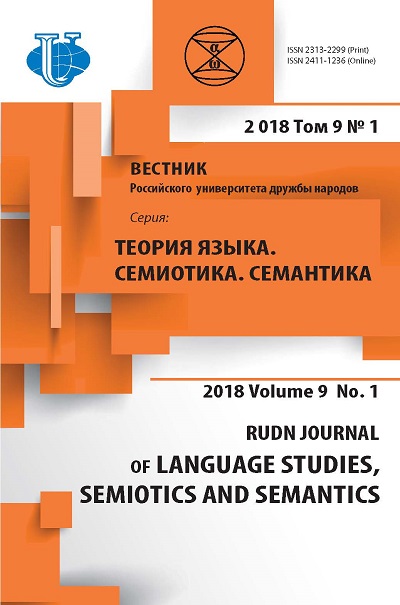‘Mr. President, discourse matters: a contrastive analysis of Donald Trump and Barack Obama’s discourse
- Authors: Casañ-Pitarch R.1
-
Affiliations:
- Universidad Politécnica de Valencia
- Issue: Vol 9, No 1 (2018)
- Pages: 173-185
- Section: POLITICAL LINGUISTICS. SCIENCE 21.0
- URL: https://journals.rudn.ru/semiotics-semantics/article/view/18275
- DOI: https://doi.org/10.22363/2313-2299-2018-9-1-173-185
- ID: 18275
Cite item
Full Text
Abstract
Whether a person is depicted as a hero or a villain, his discourse can be representative of his personality; the way the audience is addressed or the type of used words can play a part in determining the public image of any individual. This paper is contextualized within the analysis of political language. The purpose of this research is to analyze the language forms used by the current president of the United States of America, Donald Trump, and his predecessor in the White House, Barack Obama, and as well to discuss how their linguistic discourse influences their public image in the field of politics. The method implemented in this research is based on the analysis of three main focal points: the amount of words and length of sentences, the morphological composition and the use of pronouns in their speeches. The corpus of this research consists of six speeches which are equivalent in pairs and delivered by each president in the same specific contexts: their presidential announcement, election night victory and inauguration speech. The results obtained in this research show some significant differences between the two presidents regarding the analyzed items and they seem to justify how they affect their public image. In conclusion, it seems that there are some reasons why each president is using or used a specific type of discourse, which is clearly addressing certain people, groups or classes that are willing to support their ideas and proposals.
Keywords
About the authors
Ricardo Casañ-Pitarch
Universidad Politécnica de Valencia
Email: ricapi@upv.es
(PhD in Applied Linguistics) holds a MA in the English language for international trade (Business) and a BA in English Philology. He is currently an Assistant Professor at polytechnic university of Valencia (Spain). His main research interests within the field of applied linguistics are genre analysis and language acquisition. His most recent studies focus on discourse analysis and language acquisition with serious videogames Camí de Vera, s/n, 46022 València
References
- Ahmadian, S., Azarshahi, S., & Paulhus, D.L. (2017). Explaining Donald Trump via communication style: Grandiosity, informality, and dynamism. Personality and Individual Differences, Elsevier, 107 (1), 49-53.
- Ajayi, T.M. & Balogun, K.U. (2015). Politeness in the Yoruba and French Languages. International Journal of Language Studies, 8 (4), 77-94.
- Beard, A. (2000). The language of politics. London: Routledge.
- Brunell, A.B., Gentry,W.A., Campbell,W.K., Hoffman, B.J., Kuhnert, K.W., & Demarree, K.G. (2008). Leader emergence: The case of the narcissistic leader. Personality and Social Psychology Bulletin, 34 (1), 1663-1676.
- Carreon, M.C. (2006). Unguarded patterns of thinking: physical and topical structure analysis of students’ journals. The Asia Pacific Education Research, 15 (1), 155-182.
- Casañ-Pitarch, R. (2016). Case study on banks’ webpages: The use of personal pronouns. International Journal of Language Studies, 10 (4), 37-58.
- Cornish, F. (2005). “Degrees of indirectness: Two types of implicit referents and their retrieval via unaccented pronouns”. In A. Branco, T. McEnery & R. Miktow (eds.). Anaphora processing: linguistic, cognitive and computational modeling. Amsterdam: John Benjamins. pp. 199-220.
- Collins, J. (2001). Good to great: Why some companies make the leap and others don’t. New York: Harper Business.
- Crystal, D. (1980). A First Dictionary of Linguistics and Phonetics. Boulder, CO: Westview.
- Djafarova, E. (2008). Why do advertisers use puns? A linguistic perspective. Journal of Advertising Research, 48 (2), 267-275.
- Deluga, R.J. (1997). Relationship among American presidential charismatic leadership, narcissism, and rated performance. The Leadership Quarterly, 8 (1), 49-65.
- Engelen, A., Neumann, C., & Schmidt, S. (2016). Should entrepreneurially oriented firms have narcissistic CEOs? Journal of Management, 42 (3), 698-721.
- Fortanet-Gomez, I. (2004). The use of ‘we’ in university lectures: reference and function. English for Specific Purposes, 23 (1), 45-66.
- Heylighen, F. & Dewaele, J.M. (1999). Formality of language: definition, measurement and behavioral determinants. Brussels: Free University of Brussels.
- Holtzman, N.S., & Strube, M.J. (2010). Narcissism and attractiveness. Journal of Research in Personality, 44 (1), 133-136.
- Íñigo-Mora, I. (2004). On the use of the personal pronoun we in communities. Journal of Language and Politics, 3 (1), 27-52.
- Jeon, H.J. (2003). Use of film dialogues as a model of natural conversation for developing conversational proficiency. Edinburgh: University of Edinburgh. URL: http://www.era.lib.ed.ac.uk/ bitstream/1842/486/1/Jude.pdf.
- Lafiti, V. The populism of the political discourse: Metamorphoses of political rh
Supplementary files












